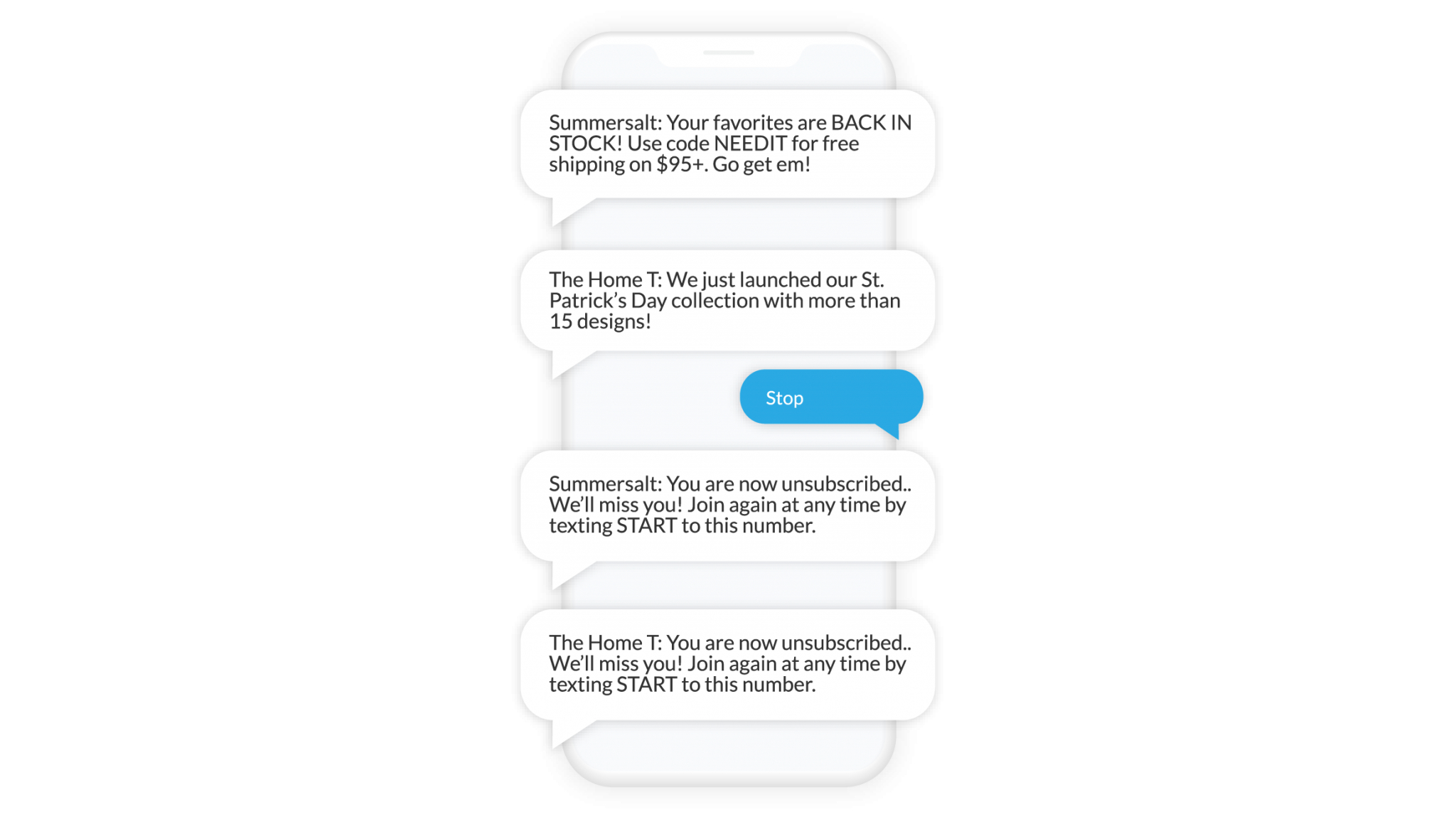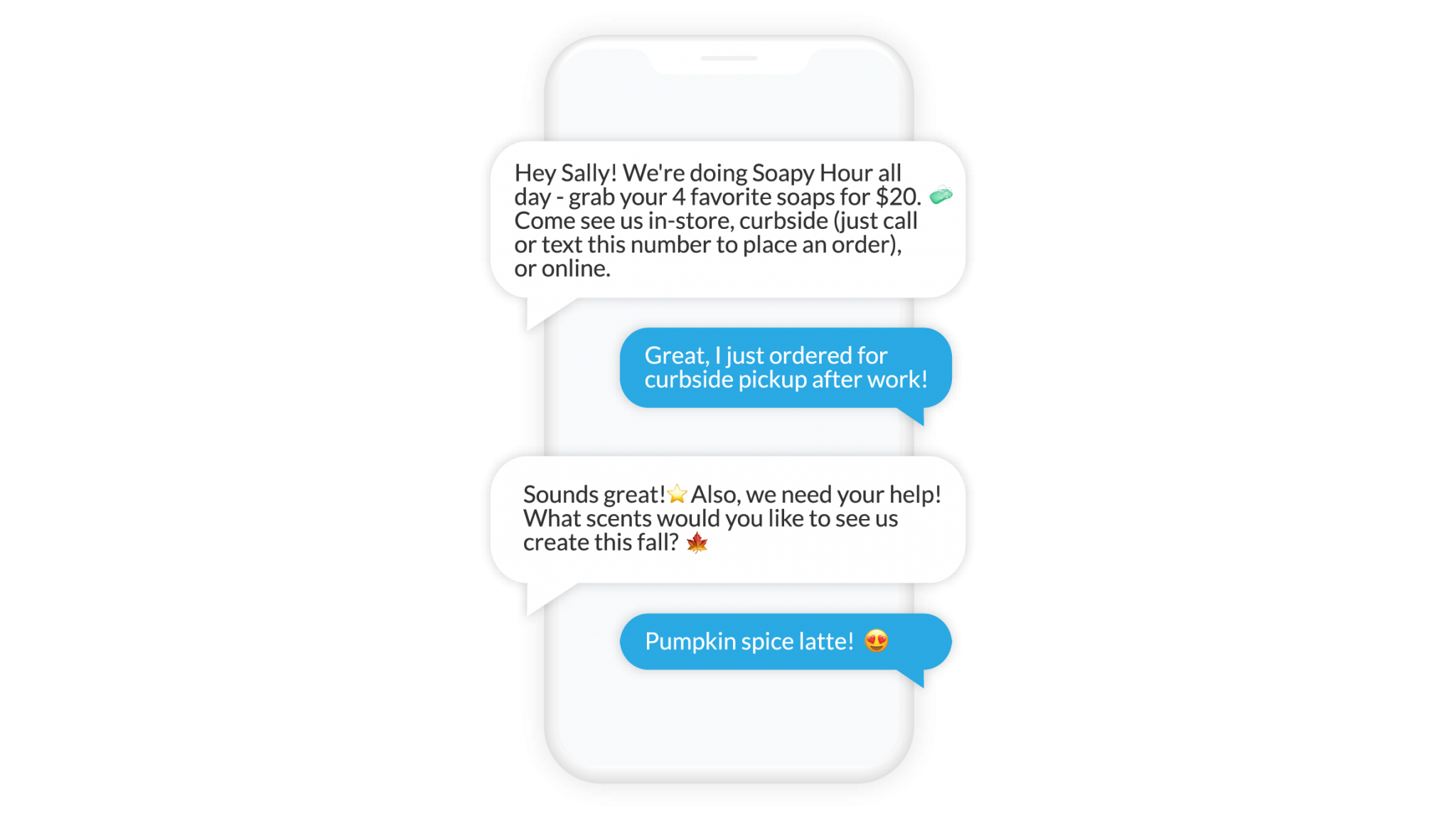If you’re a marketer looking to get your brand’s SMS marketing strategy off the ground, you may be overwhelmed by where to even begin. One of the most fundamental questions you might be thinking is: Should I be texting my customers through a short code or a long code phone number? What even is the difference?
Short Code and Long Code Definitions
A short code number is a special five or six-digit telephone number typically used to send and receive SMS and MMS messages on an Application to Person (A2P) basis, where a computer or application sends a text message to many people at once. Within short codes, there are two types: vanity and random. A vanity short code is a specific number that you choose. A random short code, on the other hand, is assigned to you without your prior review.
A long code is a standard phone number (usually ten digits) used to send and receive both voice calls and SMS messages. Ten-digit long codes are typically reserved for Person to Person (P2P) communication between two mobile phones. Carriers enforce the P2P experience by filtering through long code text messages that seem like they could be application-generated, or A2P.
Toll free numbers are a subset of ten-digit long codes. Usually starting with an “800” or “888”, toll free numbers were originally designed for business landlines but now have the ability to text message. Since toll free numbers were designed for business use cases, they have a higher throughput rate than standard ten-digit long codes but are still subject to filtering.
By now you may be wondering: Which one should I be using in my SMS marketing strategy? Let’s explore some pros and cons of each.
Short Code Pros
1. High Throughput
Short codes can send both SMS and MMS messages at a rate of 100 messages per second. This level of throughput is helpful for use cases where time-sensitive messages must be deployed to many users at once. Short code numbers have a much higher throughput rate than ten-digit long code numbers.
2. Deliverability
Since short codes are already pre-approved by carriers for A2P commercial use, they’re not at risk of carrier filtering or suspension for heavy traffic. In other words, you’re at a much lower risk of being marked as spam for sending the same message to hundreds of customers with a short code versus other options.
3. Vanity Short Codes
With vanity short codes, you have the ability to choose a specific, dedicated five or six-digit code that may be easier for your customers to remember, although an additional fee is usually applied.
Short Code Cons
1. Expensive
Although short codes have the highest throughput, they are also the most expensive option. In the U.S., a short code can cost you between $11,000 and $17,000 annually. As a result, many SMS marketing platforms will purchase a number of short codes and lease the same number to several different brands in order to save on costs.
2. Negative Customer Experience
Because several brands often share the same short code number, this can ultimately lead to a negative customer experience. While short codes are great for one-way text message blasts, they lack personalization and do not take customer responses into account.
Consider the experience below, for example. Because a number of completely separate brands share the same short-code number, it’s unclear which brand’s communication the consumer wishes to opt out of. As a result, when a customer responds “STOP,” they must be automatically unsubscribed from all of the brands that share the same short code in order to maintain TCPA compliance. Not only is this a confusing and negative experience for the customer, but your brand could potentially lose out on valuable contacts by no fault of your own.

Actual short-code SMS experience, where two different brands share the same number
3. Unable to Call
Short codes can also present more friction to the customer experience because they are unable to accept phone calls. Therefore, if your customer wishes to move a conversation from text to speak directly with a representative, they are unable to do so directly through the short code. From the perspective of your customers, this may not be as seamless of an omnichannel experience as they would expect from your brand.
Long Code Pros
1. Lower Cost
While a single short code can cost a business up to $5,000 per quarter, a standard long code usually only costs between one to two dollars to purchase, and between two and five cents to transmit text messages. In short, long codes are significantly more affordable than short codes.
2. Dedicated Numbers
Since long codes are so inexpensive, there isn’t a concern with businesses having to share numbers to save on costs. This way, your business can have its own sticky phone numbers that are dedicated to your brand.
Having a dedicated phone number reduces confusion for your customers and gives you more specific insight into their response intent. When they opt in, respond, or opt out, you know that they are responding directly to your brand’s message. Plus, your customers have the ability to save your brand’s dedicated ten-digit phone number as your contact in their phonebooks.

Two-way conversational SMS experience using Voxie
3. Ability to Call
Long code numbers further reduce friction for customers by allowing them to directly call your dedicated number. Unlike short codes, your customers will be able to dial your long code number directly and transition between channels seamlessly. You can set up call forwarding from your SMS marketing long codes to your customer service call line on the backend.
Long Code Cons
1. Lower Throughput
Unfortunately, because long codes are not intended to transmit a large volume of SMS text messages, they have a much lower throughput. Standard ten-digit long code numbers can typically only send one message per second, with toll free long codes delivering up to three times that. Still, throughput is significantly lower for long codes versus short codes.
Because long codes are much cheaper than short codes, it’s still often more cost effective to buy several long code numbers to cover the throughput requirement for your entire contact list, in lieu of one dedicated short code.
2. Deliverability
Because long code numbers are intended for P2P communication, carriers enforce stringent filtration guardrails to reduce spam for users. They constantly look for red flags that might identify a long code phone number as a bot, rather than a human. For example, if a long code number was to send thousands of the same message in a short period of time, carriers might be alerted that this behavior is suspicious for a human. As a result, your message delivery rate may suffer.
Conversely, the filtration process can actually encourage brands to customize their text messages to customers. Not only does sending unique messages personalize the experience for your individual customers, but it also makes it harder for carriers to identify the texts as A2P. As mentioned earlier, it’s also helpful to buy multiple long code numbers to proactively combat carrier filtration. Just make sure to segment your customers so that they each only interact with one of your long code phone numbers. But the biggest challenge of personalization is always scale.
Voxie is the first two-way, personalized conversational SMS platform for businesses. Not only does Voxie use dynamic fields and AI to personalize text messages at scale, but it also manages your commercial SMS phone numbers, customer segments, and response data within its platform. As a result, brands across different industries have seen click-through rates of 30% on average–versus 2.5% for email. Schedule a demo to see how Voxie can power your SMS marketing strategy.
3. Some Restrictions
Though ten-digit long code phone numbers arguably provide the best customer experience, they do present some additional restrictions. For example, toll free long codes currently don’t have the ability to send MMS (multimedia messaging service) messages. We’ve also discussed the throughput restrictions on long code numbers, making it A2P communication more difficult.
Luckily, major carriers are currently developing a concept called 10DLC, or ten-digit long code for businesses, that will help simplify A2P texting through long code numbers. In fact, Verizon introduced its sanctioned 10DLC platform for businesses to send SMS and MMS messages on February 1, 2020. Their intent was to allow businesses to better connect with their customers while also protecting consumers from unwanted spam. Other carriers are already following Verizon closely and will likely follow suit.
